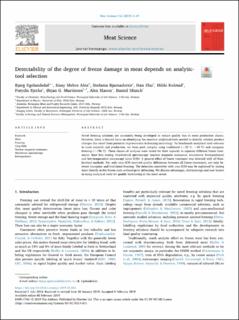| dc.contributor.author | Egelandsdal, Bjørg | |
| dc.contributor.author | Abie, Sisay Mebre | |
| dc.contributor.author | Bjarnadottir, Stefania | |
| dc.contributor.author | Zhu, Han | |
| dc.contributor.author | Kolstad, Hilde Raanaas | |
| dc.contributor.author | Bjerke, Frøydis | |
| dc.contributor.author | Martinsen, Ørjan Grøttem | |
| dc.contributor.author | Mason, Alexander | |
| dc.contributor.author | Münch, Daniel | |
| dc.date.accessioned | 2020-08-04T11:32:43Z | |
| dc.date.available | 2020-08-04T11:32:43Z | |
| dc.date.created | 2019-03-04T11:11:23Z | |
| dc.date.issued | 2019 | |
| dc.identifier.citation | Meat Science. 2019, 152 8-19. | en_US |
| dc.identifier.issn | 0309-1740 | |
| dc.identifier.uri | https://hdl.handle.net/11250/2670772 | |
| dc.description.abstract | Novel freezing solutions are constantly being developed to reduce quality loss in meat production chains. However, there is limited focus on identifying the sensitive analytical tools needed to directly validate product changes that result from potential improvements in freezing technology. To benchmark analytical tools relevant to meat research and production, we froze pork samples using traditional (−25 °C, −35 °C) and cryogenic
freezing (−196 °C). Three classes of analyses were tested for their capacity to separate different freeze treatments: thaw loss testing, bioelectrical spectroscopy (nuclear magnetic resonance, microwave, bioimpedance) and low-temperature microscopy (cryo-SEM). A general effect of freeze treatment was detected with all bioelectrical methods. Yet, only cryo-SEM resolved quality differences between all freeze treatments, not only between cryogenic and traditional freezing. The detection sensitivity with cryo-SEM may be explained by testing meat directly in the frozen state without prior defrosting. We discuss advantages, shortcomings and cost factors in using analytical tools for quality monitoring in the meat sector. | en_US |
| dc.language.iso | eng | en_US |
| dc.rights | Attribution-NonCommercial-NoDerivatives 4.0 Internasjonal | * |
| dc.rights | Attribution-NonCommercial-NoDerivatives 4.0 Internasjonal | * |
| dc.rights.uri | http://creativecommons.org/licenses/by-nc-nd/4.0/deed.no | * |
| dc.title | Detectability of the degree of freeze damage in meat depends on analytic-tool selection | en_US |
| dc.type | Peer reviewed | en_US |
| dc.type | Journal article | en_US |
| dc.description.version | publishedVersion | en_US |
| dc.source.pagenumber | 8-19 | en_US |
| dc.source.volume | 152 | en_US |
| dc.source.journal | Meat Science | en_US |
| dc.identifier.doi | 10.1016/j.meatsci.2019.02.002 | |
| dc.identifier.cristin | 1682051 | |
| dc.relation.project | Norges forskningsråd: 244441 | en_US |
| cristin.unitcode | 192,12,0,0 | |
| cristin.unitcode | 192,10,2,0 | |
| cristin.unitcode | 192,14,0,0 | |
| cristin.unitname | Kjemi, bioteknologi og matvitenskap | |
| cristin.unitname | Institutt for plantevitenskap | |
| cristin.unitname | Miljøvitenskap og naturforvaltning | |
| cristin.ispublished | true | |
| cristin.fulltext | original | |
| cristin.qualitycode | 2 | |

